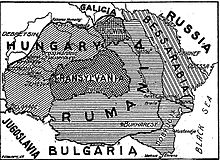Treaty of Bucharest (1916)
The Treaty of Bucharest 1916 was signed between Romania and the Triple Entente on August 4th jul. / August 17, 1916 greg. signed in Bucharest . He laid down the conditions under which Romania should enter the war on the side of the Entente, in particular territorial promises in Austria-Hungary . The undersigned states committed themselves to silence until a general peace agreement in Europe.
negotiations
In 1915, Lieutenant Colonel Christopher Thomson was sent to Bucharest as British military attaché on the initiative of Secretary of War Herbert Kitchener . But there he came to the view that an unprepared and poorly armed Romania in a war on three fronts against Austria-Hungary, Bulgaria and Turkey would be more of a burden than a help. However, this view was not heeded and, suspecting badly, he signed a military agreement with Romania on August 13, 1916. For this Thomson was appointed head of the British military mission.
contract

The treaty consisted of two parts: a political treaty with seven articles and a military agreement with seventeen articles. According to the provisions of the military agreement Austria-Hungary, the Romanian government undertook to declare war by August 28 at the latest, according to the political treaty it was to receive the following areas in return:
- Transylvania , Maramureș and the Kreisch area , which belonged to Hungary but were inhabited by a Romanian majority and a Hungarian and German minority, to the river Tisza .
- The Banat region , which also belonged to Hungary and was inhabited by Magyars, Romanians, Germans and Serbs.
- The part of the Bukovina south of the Pruth River , which belonged to Austria-Hungarians and was mostly inhabited by Romanians.
The precise boundaries set by the treaty were those of Romania before the war (Article 1) with the territories of Austria-Hungary that Romania was granted up to a demarcation line set out in Article 4.
In the fourth article, Romania also undertook to compensate Serbs from the Banat who emigrated in the two years after the peace for their property.
Article 5 of the political treaty stipulated that none of the signatories were allowed to make peace on their own initiative and obliged Great Britain, France , Italy and Russia to cede the specified areas to Romania in the event of a peace treaty. In the sixth article, the Entente Romania guaranteed equal rights at a peace conference. Article 7 obliged the undersigned to remain silent until a general peace agreement was reached.
The military agreement stipulated that Romania would attack Austria-Hungary from the south, while Russia undertook to launch an offensive on the Austrian front in support of the Romanian advance into Transylvania. In addition, Russia promised to send two infantry divisions and one cavalry division to Dobruja to protect them from a Bulgarian attack. France and Great Britain planned an offensive on the Salonika Front to persuade Bulgaria to withdraw from the war.
consequences
On the morning of August 14th, Jul. / August 27, 1916 greg. a Privy Council under the direction of Ferdinand I convened in Cotroceni Castle , who decided to accept the treaty with the Entente. On August 27, Romania declared war on Austria-Hungary and sent 440,000 soldiers across the Transylvanian Alps .
The advance of the Romanian army took place without resistance because Austria-Hungary had not stationed enough troops along the Romanian border. In mid-September, the offensive was stopped by German-Bulgarian troops when they advanced into the Dobruja and tried to outflank it from the southeast.
In October the Romanians had to withdraw from Transylvania as a result of the German reinforcement. Towards the end of 1916, the capital Bucharest fell with the Dobruja and Wallachia to the Central Powers , so that the Romanian government had to withdraw to Iași . Thomson, the leader of the British military mission, had to mitigate the consequences of the Romanian surrender and saw to it that the Romanian oil wells were destroyed so as not to be left to the Germans. From December 7, 1916 to April 6, 1917, the Bavarian Colonel Georg Steinbauer was the city commander of Bucharest .
In 1917 the Romanian army recovered and was able to stop the attempts of the Germans to break through the front, despite the withdrawal of the Russian army as a result of the February 1917 Revolution . About 220,000 Romanians died when Romania entered the war, but Romania was able to gain large territorial gains at the Paris Peace Conference in 1919 .
See also
Weblonks
Individual evidence
- ↑ a b c Constantin Kirițescu , " Istoria războiului pentru întregirea României: 1916-1919 ", 1922, p. 179
- ^ A b Sir Peter G. Masefield: To Ride the Storm: The Story of the Airship R.101 , William Kimber, London 1982, ISBN 0-7183-0068-8 , pp. 16-17.
- ^ Zara Z. Steiner: The lights that failed: European international history, 1919-1933 , Oxford University Press, 2005, p. 94
- ^ Adrian Webb: The Routledge companion to Central and Eastern Europe since 1919 , Routledge, 2008, p. 7
- ^ Charles Upson Clark [1932; under the title Greater Roumania ]: United Roumania . Ayer Publishing, 1971, ISBN 978-0-405-02741-3 , pp. 134-135.
- ↑ a b c Charles Upson Clark [1932; under the title Greater Roumania ]: United Roumania . Ayer Publishing, 1971, ISBN 978-0-405-02741-3 , p. 135.
- ^ Charles Upson Clark [1932; under the title Greater Roumania ]: United Roumania . Ayer Publishing, 1971, ISBN 978-0-405-02741-3 , p. 136.
- ↑ a b Kirițescu, p. 180
